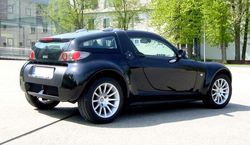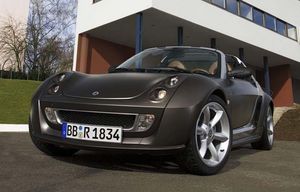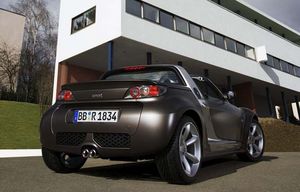.
Smart Roadster: Difference between revisions
m (→External links) |
m (→External links) |
||
| Line 67: | Line 67: | ||
==External links== | ==External links== | ||
* [https://commerce.smartusa.com/smart/?id=wikicarsroadster2 Official SmartUSA Site)] | * [https://commerce.smartusa.com/smart/?id=wikicarsroadster2 Official SmartUSA Site)] | ||
* [http://www.smart.com/ Official Worldwide Smart Site)] | * [http://www.smart.com/ Official Worldwide Smart Site)] | ||
Revision as of 23:37, 22 May 2009
The smart roadster is a two-door microcar first introduced in 2003 by Smart GmbH. Unfortunately, sales figures for the roadster and roadster coupé were far below expectations, production of both models was halted at the end of 2005. The final smart roadster ran off the production line on November 4, 2005.
History
At the 1998 Paris Motor Show, the two seater 2.5 metre long Smart City Coupe (later named smart fortwo) was launched. This was the beginning of a new car brand and the most radical vehicle concept to hit the European market since the bubble cars of the 1950s. It was also the beginning of a very hard time for smart. The city coupe had stability problems that were uncovered only immediately prior to launch. These forced a package of alterations to be made that were both expensive and compromised the car’s handling, ride and gear shift. Peoples’ concerns over its stability, combined with smart’s elitist marketing and the sheer radicalness of the car’s conceptual and aesthetic design resulted in poor sales. Production projections were slashed from 200k per year to 80k per year. For a new brand with just the one product, this was close to disastrous.
Inside the company, the evangelical buzz that had been behind this radical City Coupe went sour quickly. New management was put in place, new marketing initiatives were introduced and further revisions to the car’s chassis were made. There was the very real possibility of the company dying on its feet. Within the design group the large proportion of contract workers had long since left and the next planned smart, a four seater, was still awaiting a strategic partner to be found before much work could be done. It was under these inauspicious circumstances the smart roadster was born.
Design & Development
Under Design Director Jens Manske in autumn 1998, the 12-14 strong design group started to sketch various possible future Smart cars. A small team of designers and engineers within the group realised that the powertrain of the City Coupe was ideal for a small sports car; a compact and shallow turbocharged engine powering the rear wheels via a sequential 6 speed gearbox.
Combined with smart’s ‘reduce to the max’ philosophy and general innovative approach, this led to a concept of a super compact, practical and also pure sports car; a modern equivalent of the Austin-Healey Sprite ‘Frogeye’ (which begat the MG Midget). Two quarter scale exterior and two quarter scale interior models were made in February 1999 with Volker Leutz’s exterior and Christoph Machinek’s interior proposals chosen for development into a full size clays in April, again, with some involvement from Mauer. The design of the car was well progressed by the time Michael Mauer officially arrived from Mercedes-Benz advanced design center in Japan to swap positions with Menske in May 1999. Mauer worked closely with the design team to quickly develop the roadster, with the intention now of producing a show car for the forthcoming Frankfurt show.
By June the full size models of the roadster were handed over to Stola in Italy for development into the show car model, which was produced in about three months for the car’s debut at the 1999 IAA motor show in Frankfurt. The roadster concept was well received at Frankfurt and helped to convince management that the car should be developed for production. At the same time a decision was made to develop Mauer’s idea for a coupe version of the design as a concept car for Paris motor show a year later. As development of the coupe concept car began, so the roadster show car was scanned (digitised) and then developed digitaly over the following year with both exterior and interior designs signed off in November 2000. Color and trim design continued in parallel, but for longer, with sign off in November 2001.
By early 2000 the smart city coupe was starting to gain in its rate of sales, the cabrio version made a significant addition to total Smart sales and the ForFour was well under way now it was sharing components with Mitsubishi. In March 2000 Mauer left Smart for Saab to be succeeded by Hartmut Sinkwitz (who also came from Mercedes) in May 2000. As the third design director of Smart during the design development of the roadster, Sinkwitz had to bring the concept to production reality in a very short time. This may have been made relatively easy by the Roadster having been designed right from the start to use an existing powertrain and incorporate other City Coupe components. Given some of the advanced design features, it is a credit to the design team that so much of the concept car made it to production.
Concept Car
Shown at the 2000 Paris motor show in concept car form, the ‘roadster coupe’ was already on its way to production. It shared the design of the Roadster from the doors forward, but had a glass targa roof and rear structure akin to a very small estate in a similar way to the BMW Z3 coupe and the Saab 9X concept car developed under Mauer at Saab a few years later.
Production versions of both roadster and roadster coupe debuted together at the 2002 Paris Motor Show and were available to buy within a few months. Both cars were unique in the market, significantly smaller that the Toyota MR2, MG TF, Fiat Barchetta and Mazda MX5, but offering similar performance and practicality to the base versions of these cars whilst being significantly more fuel efficient.
But what is particularly interesting about this Smart pair is that although they competed for attention from those already considering a sports car, they also appealed to another audience. Sports cars have always been bought with the heart not the head. The new breed of post-MX5 sports cars eradicated some of the functional barriers to purchase such as leaking, unreliability and reduced safety so that the head can accept the car the heart desires. But the smart goes further than this, offering a different image to existing sports cars and one that appeals to a more educated, responsible and forward looking audience for whom buying a sports car is an anathema. It still projects onto its driver the sports car image of a fun loving, dynamic person, but has none of the almost arrogant go get ‘em, thrusting and care free attitude typically intrinsic in traditional sports cars’ identities - because it is so small and because it is a Smart. And because it is as fuel efficient as a super mini, will depreciate exceptionally slowly, and has the quality and safety expected of its Mercedes-Benz parentage.
Production
The smart roadster and roadster coupé were introduced in 2003, based on a stretched platform of the ForTwo (full length is 3427 mm). The two variants are meant to be reminiscent of the British roadster of yore, such as the Triumph Spitfire or the MG B. Both the Roadster and Roadster Coupé are available with a removable Targa roof or an electrical Softtop. The Roadster is powered by 45 or 60 kW (61 or 82 PS) versions of the turbocharged 3-cylinder engine in the rear, which is engineered by Mercedes-Benz. The roadster coupé has only the more powerful 82 PS engine. A steering wheel with Formula 1-style gearpaddles, to control the semi-automatic sequential transmission, is optional. With weight as low as 790 kg, it is meant to provide the emotion of driving a sports car at an affordable cost. Still, the Roadster's price is not very far from that of a Fiat Barchetta or Mazda MX-5.
Both the roadster and roadster coupé are available in Brabus-tuned versions with power increased to 74 kW (101 PS). The Brabus versions have a different twin sports exhaust, lower suspension, polished six-spoke aluminum alloy Monoblock VI 17" wheels, front spoiler, side skirts and radiator grille. Exclusive Brabus interior includes leather trimmed dashboard, alloy-effect accent parts, instrument graphics, leather/aluminium gearknob, aluminium handbrake handle, aluminium pedals and Brabus labeled floor mats.
Brabus V6 Bi-Turbo prototypes
In 2003 german tuninghouse Brabus created a prototype version of the roadster coupé with two merged 3-cylinder engines to celebrate the 100th anniversary of the Solituderennen. This V6 bi-turbo powerplant had a maximum power of 218 PS for a weight of only 840 kg, giving it the same power-to-weight ratio as a Porsche 911 Carrera 4S. smart claimed the car could accelerate to 100 Km/h in under six seconds.
Since the twin-turbo V-6 occupies almost as much space as two three-cylinder engines, the fuel tank had to be relocated to the nose of the car, where a luggage compartment used to be. It comes in the form of a Formula 1-type foamrubber fuelbladder. The bigger engine also forced a change from separate coil springs and dampers to concentric units to support the de Dion rear suspension. This machine also included features like a Startbutton, a fire extinguisher from an oilrig, slim racing bucket seats trimmed in black Alcantara & red stitching and four-point shoulder harnesses. Brabus removed the radio and airconditioning for "packaging reasons". Also it has no traction control because they weren't able to reprogramm it for the extra power. Ten cars were built and presented at the Castle Solitude. Unfortnuately they are not available for sale and are even not allowed to drive on the public road in Germany. Some of Mercedes' race drivers, like Markus Winkelhock, drove guests around the events race track.
Collector's Edition 2006
In March 2006 Smart unveiled the final variant of the Roadster on the Geneva Motorshow: a limited collector's edition.
It was based on the topmodel Brabus Xclusive with 101 PS and came with a satin brown-metallic paintjob. The interior had brown leather and nice materials everywhere. It had the new Runline aluminium wheels and Brabus exhaust, frontspoiler and side fenders. Apparently only about 50 cars are made, although that number might rise if there are enough orders.
Project Kimber and the "MG" Smart Roadster
Project Kimber is an acquisition group, run by David James, that was founded to buy the assets of the MG Rover group. In 2006, it was reported that David James had entered talks with MG Rover's new owners the Nanjing Automobile Group to buy the MG brand in order to produce a number of sports cars based on the smart roadster design.
On Friday February 17 2006, The Times newspaper reported that Mr James was in discussions with DaimlerChrysler to buy the roadster's design, technology and equipment for approximately £13 million. The equipment would be then transferred from the smart factory to a former Dunlop tyre factory in Coventry where the roadster would be built under the MG brand. It is understood that Project Kimber is being funded by Grant Gazdig's Access Capital firm, as well as a private equity firm called European American Securities.
Error creating thumbnail: Unable to save thumbnail to destination
| ||
| SMART | ||
|
Mercedes-Benz | Maybach | Smart | Mitsubishi | GEM | Mercedes-AMG | Freightliner | Mitsubishi Fuso Truck and Bus Corporation | OriOn | Setra | Sterling Trucks | Thomas Built Buses | Western Star | McLaren Group Current
forfour · Roadster · formore · Crossblade Concept CrossTown · 454 WWT Concept · · · Swatch | ||
| Swatch and Mercedes-Benz | Corporate website | A division of the DaimlerChrysler Group |




